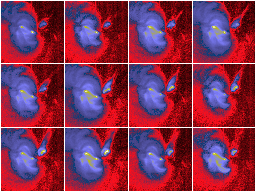
One of Yohkoh's nicer early discoveries was the X-ray jet phenomenon (see here for the "discovery paper", or [1], [2], [3], [4], [5] for various easy-on-the-eye science nuggets related to this discovery). In an X-ray jet, a column of hot plasma suddenly shoots up into the corona, invariably with a microflare at its base. The basic interpretation of the phenomenon is in terms of emerging-flux reconnection, as in the Heyvaerts-Priest-Rust model. Another early discovery tied these jets to meter-wave Type III bursts, streams of non-thermal electrons accelerated near the Sun and escaping into the outer corona.
In studying the physics of jets, we've been hampered by their perverse ability to happen outside our high-resolution field of view. In the routine Yohkoh movie, we get few images - typically at a shortest (best) interval of four minutes, and with 5 arcsec pixels rather than 2.5 arcsec. So we are grateful when one conveniently (and entirely accidentally) actually happens in our high-resolution field of view - see an earlier example which might have important and interesting interpretations. This one may not, but still it was well-observed:

Clickez, s'il vous plait, to get an enlargement with annotations.
The sequence of images below cover 20 minutes, and each frame is about 100,000 km on a side.

Perhaps there is a little discovery here, because - on second look - the jet really seems to come from a fainter loop to the north of the microflare loop (see the labeled image above), to which it's approximately parallel. So probably in this case the main microflare brightening proceeded independently of the jet formation - associated, but not physically connected. In the standard theory, the large-scale coronal reconnection that unleashes the jet also directly creates the hot loops of the associated flare. The standard theory wouldn't necessarily predict the apparent displacement of the jet source and the bright loop. When a theory doesn't predict an observation, it always gladdens the hearts of the observer!
Given the strong hint above that the geometry of an X-ray jet is interesting, after all, clearly we've got to invoke TRACE data with its astonishing resolution. A recent paper by Alexander and Fletcher confirms that TRACE can see these features beautifully. But their paper remarks "...existing theoretical models capture the essential physics of the jet phenomena..." - really? TRACE did not observe this particular jet, but did observe earlier similar ones from about the same place. Further study is in order, of course...
August 11, 2000